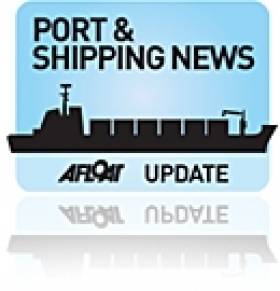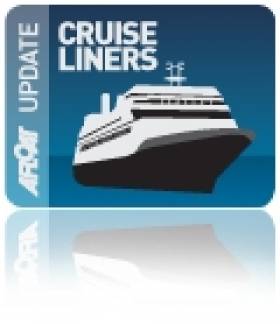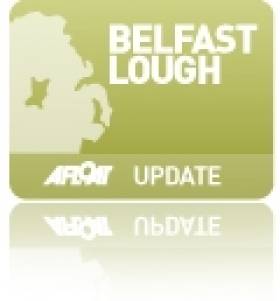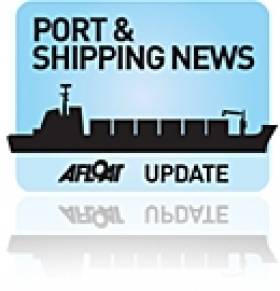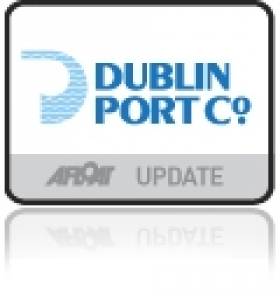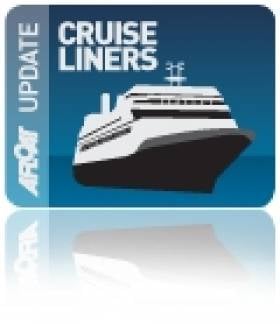Displaying items by tag: Ports and Shipping
Mainport Purchase Seismic-Support Ship
#MAINPORT ACQUIRE VESSEL – Cork based Irish Mainport Holdings has acquired the seismic-support ship, Forth Hunter, which was handed over to senior management officials of the Irish company in Edinburgh last week, writes Jehan Ashmore.
The vessel has been renamed Mainport Kells and is currently working out of the Norwegian port of Bergen for clients on a new long-term contract working in the seismic industry in the North Sea.
She was built in 2008 at the Shin Yang shipyard, Malaysia and her principle dimensions are 27m (length) x 11m (beam) x 4.3m (draft). Accommodation is available for up to 12 crew on board the 467 gross tonnage vessel which flies the Gibraltar flag.
The newcomer joins the group's large fleet which includes subsidiary Mainport International Corporation which has three vessels in service.
Ports & Shipping Review: Champagne Voyage, Cruiseship Safety, Scienceship, Ferry Sold, P&O 175th,Belfast Boost
#PORTS & SHIPPING REVIEW - Over the last fortnight Jehan Ashmore has reported from the shipping scene which saw the second WFSV Gardian 10 make a delivery 'Champagne 'promo-voyage to her UK East coast based owners.
Following the Costa Concordia incident, tighter inspections of vessels visiting our ports will be carried out according to the Marine Survey Office.
With all things scientific with the ESOF conference in Dublin, as part of Dublin City of Science 2012, there is still time to apply for the Marine Institute's training position for their research vessel operations.
The last ever passenger (incl. car-ferry) built by Harland & Wolff in 1981, the St. David for Sealink/British Rail departed on her long delivery voyage for new Indonesian owners. For most of her career she served as the Stena Caledonia on the North Channel routes until her recent sale and renaming to Portlink.
P&O Cruises Arcadia sailed into Dublin Bay following a spectacular gathering of her fleetmates in Solent waters to celebrate the 175th anniversary of the world famous shipping company. P&O can trace their origins with an Irish connection as the Dublin and London Steam Packet Co. chartered their paddle-steamer William Fawcett, the vessel being regarded as the first ship working for P&O.
Belfast Harbour revealed record traffic levels for the year 2010-2011 as outlined at the company's annual report. The port showed a 2% rise in profit before taxation to £17.8m and a 4% increase in turnover to £36.1m.
Also in the northern port, the new iconic waterfront landmark of the Belfast Titanic visitor attraction is a key contributory factor in drawing the cruiseship sector. A total of 41 cruise callers are scheduled in 2012 which is an increase to last year's 32 ships.
#CRUISE LINERS – This year Belfast Harbour can look forward to a boost in the cruise sector as more than 40 calls are scheduled during the season, the increase is largely attributed to the opening of the iconic visitor attraction of Titanic Belfast, writes Jehan Ashmore.
In 2012 the port is to see an impressive 32% increase on last year with 41 cruise ships bringing almost 75,000 visitors to the port compared to 2011 where 32 ships called with 58,000 passengers.
The ports cruise facility at Stormont Wharf, which cost £10m, continues to pay dividends with its advantage of accommodating large cruise ships operating in the Irish Sea. The wharf at 1km in length is the longest deep-water berth on the island of Ireland.
Among this season's cruise operators visiting the harbour are Cruise & Maritime Voyages (CMV), Fred Olsen Cruise Line, Holland America Line (HAL), P&O Cruises, Prestige Cruises, Princess Cruises and Saga Cruises. Click HERE for a list of cruiseships calling to the port.
#BELFAST HARBOUR -The largest port in the north reported improved turnover and profit during 2010-2011, according to the annual report of Belfast Harbour.
The port showed a 2% rise in profit before taxation to £17.8m and a 4% increase in turnover to £36.1m. Underpinning the harbour's performance were record levels of tonnages handled during the period - up 7% to 17.6m tonnes. Although some sectors, such as those related to construction, continued to struggle, this was offset by growth elsewhere.
The number of freight vehicles passing through the port rose by 14% to 357,000 and a record four million tonnes were handled in the dry-bulk sector, which includes trades such as aggregates and coal.
Belfast Harbour noted that capital expenditure projects valued at £18.3m were completed during 2010-11. A further £53.8m was committed to additional projects at the year end, principally the development of the UK's first dedicated offshore wind logistics terminal for DONG Energy.
Len O'Hagan, Belfast Harbour's Chairman, said: "In spite of ongoing sluggishness in both the UK and Irish economies, Belfast Harbour has posted a very strong set of results for 2011, reflecting the diverse nature of the business and a long-term strategy of major capital investment to ensure that Belfast offers the most modern maritime facilities on the island.
"Significant uncertainty, however, still exists in the global economy, with the UK officially falling back into recession and the continuing eurozone crisis which is undermining business confidence throughout the continent and beyond.
"There are still opportunities for growth, though, particularly in renewable energy where Belfast Harbour is investing £50m in a new terminal for the assembly of offshore wind turbines. There have also been opportunities to further develop Belfast Harbour Estate, not least the Titanic Belfast visitor attraction, which received a £13.6m donation from Belfast Harbour, and the Northern Ireland Science Park which was the subject of a £6m investment by the Harbour to facilitate a 55,000 sq ft expansion."
During the year the port benefitted from several developments within the Irish Sea ferry sector, including the opening of Stena Line's new Scottish terminal at Loch Ryan Port (Cairnryan) and introduction of a pair of larger and more modern vessels. During this timeframe Stena Line had completed its takeover of DFDS Seaways Belfast - Birkenhead route and freight-only service to Heysham.
Mr O'Hagan added: "Although the overall performance of Belfast Harbour has been strong, it is clear that economic recovery across the UK and Ireland remains patchy. Belfast Harbour, however, is committed to its long-term strategy of investing in infrastructure to maintain the Port's competitiveness and provide much needed capital projects for the construction industry."
#PORTS & SHIPPING – Today is the International Day of the Seafarer, and people around the world are being asked to use social networks to highlight just how important seafarers are as they transport more than 90% of global trade which are vital to our daily lives.
On this second year of the Day of the Seafarer, people are asked to tell the world of an object in their daily life that you can't live without, and which came by sea.
Take a photo of the object, write a description, record a song, make a film, whatever you prefer: and then just post it on the social platform of your choice and add the campaign slogan: "thank you seafarers".
Seafarers leave their homes and families, often for long periods to ensure that essential items and commodities on which our lives depend arrive safely at our homes.
So show the seafarers of the world - and your friends, too – your appreciation of the extraordinary services they render every day of their professional lives, under demanding and sometimes dangerous circumstances.
Day of the Seafarer is an innovative campaign that harnesses the power of social media to raise awareness of seafarers and their unique role. Everyone, regardless of where they live, can join the campaign online. So, on 25 June, you can join in by:
Sharing your post on Facebook, if you have pictures, videos or any special message, please share them on our wall.
Sending us a message @IMOHQ and @SeafarerDay using hashtag #thankyouseafarer
On pinterest, you can pin a picture of your chosen object with the caption "Day of the Seafarer"
For more infomation and for how participants can download the toolkits available of the campaign click HERE. In addition for a video message by Koji Sekimizu, Secretary-General of the International Maritime Organization (IMO).
The IMO is the United Nations specialized agency with responsibility for the safety and security of shipping and the prevention of marine pollution by ships. The organisation is headquartered in London on the banks of the Thames.
#VESSEL VOLVO VILLAGE – As previously reported the ocean going heavy-lift container cargoship Deo Volente (2007/2,999grt) which is carrying the spectacular Volvo Ocean Race 'pop-up' spectator village from Lisbon is en-route off the Clare coast and is due to dock in Galway Docks this afternoon, writes Jehan Ashmore.
The high-tech village which is assembled from 70 crates and is one of two such villages which have accompanied the race across the globe is in the holds of the 105m long Dutch owned vessel. When Deo Volente enters through the dock she is to berth at Dún Aengus Dock North.
According to Capt. Brian Sheridan, Harbourmaster of the Galway Harbour Company, the containership is the first the port has ever had to handle and the unloading is part of "the unfolding jigsaw that is the Volvo Ocean Race".
The unloading process will create huge excitement as the village emerges from its containers and transforms the dockside into a gigantic sports and entertainment arena.
Deo Volente is operated by Hartman Seatrade, which they classify as a mini heavy-lift vessel. She is capable of carrying vessels as deck-cargo, unusual sized cargo as well as 236 TEU containers. On board are two 120 mt (metric tonnes) cranes, built by Liebherr which are mounted on the starboard side. Using both cranes the loading gear can handle a maximum tandem total weight of 240 mt.
The appearance of such a vessel will no doubt bring back memories to many Galwegians when in 2011 there was the saga of attempting to load two former Aran Islands fast-ferry sisters bound for new owners in Mauritius.
Albeit on this occasion of the impending Volvo Ocean Race, the process of unloading the pop-up village is far more conventional in the form of containers, though what is required is the 60 specialist construction workers involved in the task of assembling the village. The vessel is to stay in port overnight and scheduled to depart tomorrow afternoon.
As for last year's protracted loading of the fast-ferries, it was heavy-lift ship Thor Gitta (4,078grt) that stepped in after another similar vessel, Pantanal (7,837grt) ran aground in Rossaveal on 31 March. It was from the joint fishing and ferry port, where the ferries were originally due to be loaded.
Instead the ferries had to transfer to Galway Harbour where the vessel eventually departed nearly a month later on the 8,300 mile delivery voyage to the Indian Ocean.
#PORTS & SHIPPING REVIEW: Over the last fortnight Jehan Ashmore reported the shipping scene which saw President Higgins officially reopen the National Maritime Museum of Ireland in Dun Laoghaire.
The President was again on duty on the far side of Dublin Bay the next day to welcome the London Olympics 2012 Torch Relay on its first visit to the state in Howth Harbour, where the headquarters of the Olympic Council of Ireland are based.
The mid-west port of Galway was where the small German cruiseship Bremen made a port of call while at anchorage in Galway Bay.
Returning to the east coast in Dun Laoghaire Harbour, where the Water Wag's the oldest one design racing class in the world celebrate their 125 anniversary regatta week which culminates today.
Outside the harbour in Dublin Bay, the sight of a rig re-appearing was not for oil but for further preliminary work as part of the €220m Dublin Bay Project, where a new sewage pipeline outfall is to be built from Ringsend.
On the other side of the Irish Sea, the cruiseship Ocean Countess departed Liverpool City Cruise Terminal bound for Cobh. Her departure coincided on the 30th anniversary of the end of the Falklands Conflict, where in 1982, the cruiseship was used as a troopship to assist logistical operations after the 10-week long war ceased in June of that year.
Ardmore Shipping Call for Importance of Human Component in Technical Performance Management
#PORTS & SHIPPING – Gery Docherty, Technical Superintendent at Ardmore Shipping Ltd spoke of the importance of the human component in technical performance management at last month's 'Propulsion & Emissions Conference 2012' organised by The Motorship.
Among the conference guest speakers were representatives of the IMO, European Commission and Germany's Federal Ministry of Transport also were in attendance.
Docherty also delivered a clear message to delegates for the need for the shipping industry to prepare for the impending 2015 sulphur regulations, which will see far tighter limits on sulphur emissions in designated Emission Control Areas.
In addition he provided an overview of the options available, including low sulphur fuel products, exhaust gas cleaning systems and LNG as a ship's fuel.
However, as well as technology solutions, Ardmore Shipping which currently has newbuilds on order from South Korea, belief in the importance of the human element in every aspect of management. This covers plant, generator, fuel oil systems and bunker performance management, along with the enduring value of basic skills and the essential role played by all stakeholders: owners, technical managers, superintendents and crew members.
Docherty also stressed that non-compliance with the 2015 regulations is not an option. He also outlined the considerations for Ardmore Shipping as it prepares to meet the challenges posed by the MARPOL Annex VI amendments, which take effect on 1 January 2015.
Former Dublin Port Tug on Delivery Voyage to Portugal
#SOLD DUBLIN TUG SETS SAIL – With a career spanning nearly four decades, the former Dublin Port Company tug Ben Eadar (1973/198grt) departed over the weekend on her delivery voyage to serve new owners in Portuguese waters, writes Jehan Ashmore.
Prior to her departure, Ben Eadar was moored alongside the grab-hopper dredger Hebble Sand (1963/757grt) in Alexandra Basin, which too awaits her delivery voyage to new owners.
It was envisaged that the veteran tug would be towed on the delivery voyage to Portugal however she left Dublin Port for the final time on Saturday under her own power. Since her departure the 17 tonnes bollard pull (tbp) veteran vessel called en route to Milford Haven on Monday before making a longer leg across the Bay of Biscay.
She still retains her original name since her launch at the Yorkshire shipyard of Richard Dunston Ltd, Hessle, however she was re-flagged in Vanuatu, where her change of registry is Port Vila, the capital of the south Pacific island nation.
Ben Eadar became the last of three tugs sold this year to depart Dublin Port, having been brought by ARPA & Co. of Setubal in Portugal. The 17-tonnes bollard pull (tbp) tug follows her younger 35tbp Voith- Schneider fleetmates, Cluain Tarbh (1991/268grt) and Deilginis (1997/335grt). The former was sold to Scottish interests and the latter remains in Irish waters based out of Killybegs.
The trio represented the last of the older generation of a tug fleet built for the Dublin Ports & Docks Board (DP&DB) which is now the Dublin Port Company. The tugs were all given names of Dublin Bay coastal suburbs spelt in Irish and were replaced by a pair of more powerful 50tbp newbuilds introduced from 2009.
Cruise Europe Appoints Port of Cork Official
#CRUISE SHIP SECTOR – Cruise & Ferry reports that Captain Michael McCarthy of the Port of Cork Company was unanimously chosen to become the new chairman of industry association Cruise Europe.
At the association's conference held last month at Royal Greenwich, McCarthy was chosen to replace Dirk Moldenhauer, who held the role for the last four years.
With 40 years of maritime experience in positions as varied as master at sea, marine surveyor and deputy harbour master, McCarthy is currently commercial manager at the Port of Cork Company.
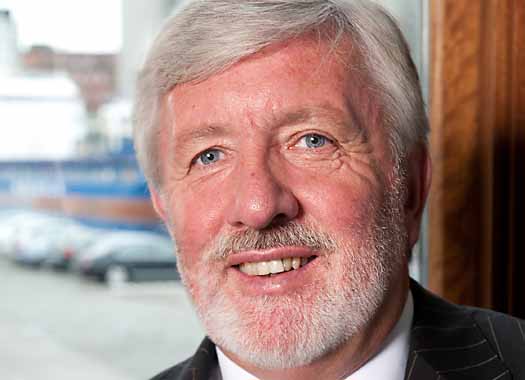
Captain Michael McCarthy is the new new chairman of industry association Cruise Europe
McCarthy thanked Moldenhauer for steering Cruise Europe through a modernization process and making it more professional and responsive to the requirements of its members. He said Cruise Europe's vision was "to deliver to the cruise companies a world class cruise destination on behalf of our members" and that he would continue working with members to promote and develop "must see" North and Atlantic European destinations.
He added: "We are facing major challenges and it is vital that Cruise Europe members support the cruise lines through greater communications and develop outstanding service while keeping costs tightly under control, particularly as the lines adapt to the Emissions Control Area regulations from 2015."
Port of Cork press release below:
PRESS RELEASE
Captain Michael McCarthy, Port of Cork, Elected as Chairman of Cruise Europe
Irish Cruise Line Business Worth an Estimated €60M to the Irish Economy
At the Cruise Europe Conference 2012 held at Royal Greenwich, London in April, Captain Michael McCarthy of the Port of Cork, was unanimously elected Chairman of Cruise Europe. Michael brings over 40 years of maritime experience to the position having served as Master at sea, Marine Surveyor, Deputy Harbour Master and is currently Commercial Manager with the Port of Cork Company.
Michael endorsed the vision of Cruise Europe which he said is "to deliver to the cruise companies a world class cruise destination on behalf of our members". Between 2005 & 2010, there has been an increase of 84% growth in the economic impact of the European Cruise Industry, bringing the total contribution to €35 billion.
On average there are over 200 cruise calls to Ireland per year carrying approximately half a million passengers and crew. This cruise business contributes an overall economic contribution estimated to be worth €60 million to the island of Ireland.
Commenting on the Irish cruise business, the newly elected chairman of Cruise Europe, Captain Michael McCarthy said: "There are many indirect economic and tourism benefits to Ireland from the cruise sector, as well as the benefit of introducing Ireland to new markets and growing business opportunities. Cruise visits help to showcase Ireland's world class shore products, destinations and highlight all that Ireland has to offer visitors."
He continued: "One of Ireland's advantages is the strategic and geographic spread of its numerous ports, many of which are in close proximity to world class tourism destinations and it is with this in mind that Ireland will be promoted with the North and Atlantic European destinations to develop thriving and "must see" destinations."
The cruise industry, as a whole, faces major challenges and it is vital that Cruise Europe members support the cruise lines through effective communications and develop an outstanding service while keeping costs tightly under control, particularly as the lines adapt to the ECA [Emissions Control Area] regulations from 2015.
"These regulations, which will come into force on January 1st 2015, will reduce sulphur limits in fuel to 0.10%. This will result in vessels operating from the English Channel through the North Sea into the Baltic from 2015, to have increased operating fuel costs of over 50%."
McCarthy also outlined the benefits of being a member of Cruise Europe and the commitment to working closely with the ECC and other representative organizations.



























